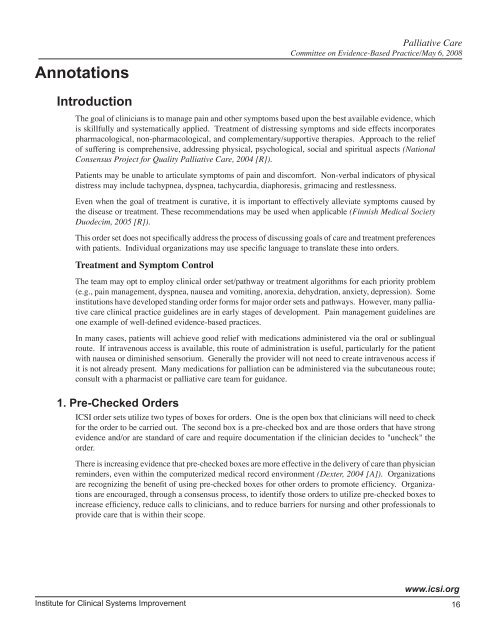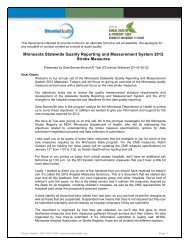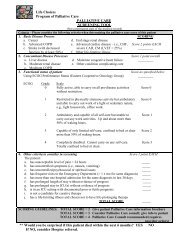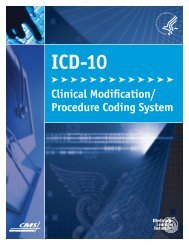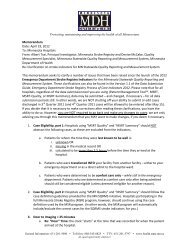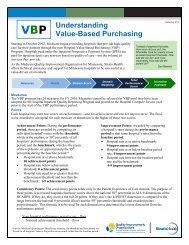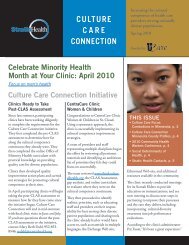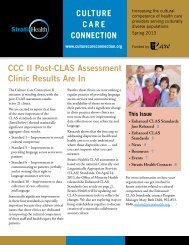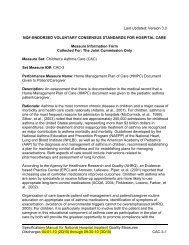Palliative Care Order Set - Stratis Health
Palliative Care Order Set - Stratis Health
Palliative Care Order Set - Stratis Health
Create successful ePaper yourself
Turn your PDF publications into a flip-book with our unique Google optimized e-Paper software.
Annotations<br />
<strong>Palliative</strong> <strong>Care</strong><br />
Committee on Evidence-Based Practice/May 6, 2008<br />
Introduction<br />
The goal of clinicians is to manage pain and other symptoms based upon the best available evidence, which<br />
is skillfully and systematically applied. Treatment of distressing symptoms and side effects incorporates<br />
pharmacological, non-pharmacological, and complementary/supportive therapies. Approach to the relief<br />
of suffering is comprehensive, addressing physical, psychological, social and spiritual aspects (National<br />
Consensus Project for Quality <strong>Palliative</strong> <strong>Care</strong>, 2004 [R]).<br />
Patients may be unable to articulate symptoms of pain and discomfort. Non-verbal indicators of physical<br />
distress may include tachypnea, dyspnea, tachycardia, diaphoresis, grimacing and restlessness.<br />
Even when the goal of treatment is curative, it is important to effectively alleviate symptoms caused by<br />
the disease or treatment. These recommendations may be used when applicable (Finnish Medical Society<br />
Duodecim, 2005 [R]).<br />
This order set does not specifically address the process of discussing goals of care and treatment preferences<br />
with patients. Individual organizations may use specific language to translate these into orders.<br />
Treatment and Symptom Control<br />
The team may opt to employ clinical order set/pathway or treatment algorithms for each priority problem<br />
(e.g., pain management, dyspnea, nausea and vomiting, anorexia, dehydration, anxiety, depression). Some<br />
institutions have developed standing order forms for major order sets and pathways. However, many palliative<br />
care clinical practice guidelines are in early stages of development. Pain management guidelines are<br />
one example of well-defined evidence-based practices.<br />
In many cases, patients will achieve good relief with medications administered via the oral or sublingual<br />
route. If intravenous access is available, this route of administration is useful, particularly for the patient<br />
with nausea or diminished sensorium. Generally the provider will not need to create intravenous access if<br />
it is not already present. Many medications for palliation can be administered via the subcutaneous route;<br />
consult with a pharmacist or palliative care team for guidance.<br />
1. Pre-Checked <strong>Order</strong>s<br />
ICSI order sets utilize two types of boxes for orders. One is the open box that clinicians will need to check<br />
for the order to be carried out. The second box is a pre-checked box and are those orders that have strong<br />
evidence and/or are standard of care and require documentation if the clinician decides to "uncheck" the<br />
order.<br />
There is increasing evidence that pre-checked boxes are more effective in the delivery of care than physician<br />
reminders, even within the computerized medical record environment (Dexter, 2004 [A]). Organizations<br />
are recognizing the benefit of using pre-checked boxes for other orders to promote efficiency. Organizations<br />
are encouraged, through a consensus process, to identify those orders to utilize pre-checked boxes to<br />
increase efficiency, reduce calls to clinicians, and to reduce barriers for nursing and other professionals to<br />
provide care that is within their scope.<br />
www.icsi.org<br />
Institute for Clinical Systems Improvement<br />
16


